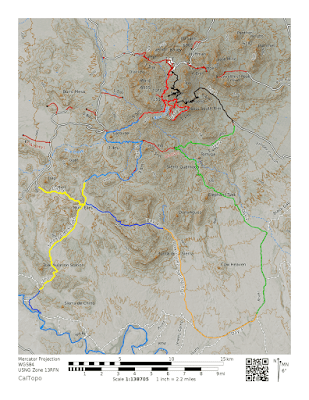Basic Bike Maintenance 101
Basic Bike Maintenance 101
Today our post will be a continuation in our
mountain biking series. This post was
inspired by a reader question, “how do I get my mountain bike ready to ride
after not using it in a while?” However, this quick guide will be beneficial to both road and mountain bikes. In
addition, the trail I ride is extremely dusty so a good cleaning is in order.
Getting your bike ready
All the steps covered here will be easy enough to
perform yourself. However, if you find
any issues out of your ability range or don’t have the time, there is always the
option of taking it to your local bike shop.
Your local bike shop will charge you around $60 for a basic
cleaning/tuning job. If there is a
repair issue, it could get more expensive.
Our
required tools for the job: towels, mild detergent, and a toothbrush (if you
have fancy bike cleaning brushes, use those too). If you have one, using a bike stand will make all the task easier. If you don't have a bike stand, either prop your bike on a chair or flip in upside down so it rest on the seat and handle bars.
Step 1: Clean the Bike
A
clean bike will stand up to time better than a dirty bike. Dirt increase friction on your moving parts,
which results in wear and tear. In
addition, dust can allow rust spots to form on metal components, which weakens
the structure. Therefore, it is
important to occasionally clean your bike.
Begin
by wipe down the frame, pedals, and seat first.
Then move on to the drive chain (chain, chain rings, derailleurs, and
cassette). Third, wipe down your brake
system. For disc brakes clean the disc
and for v-brakes clean the rubber brakes and wipe down your rims. Remember when cleaning your brakes, it is essential not to get oil or grease on the pads or disc. Oil on your brakes will result in reduced friction and decrease your ability to stop. Finally, use a clean dry towel to remove any
moisture from your bike.
Step 2: Check the Wheels
First
check out the tire by visually inspecting to make sure your tires are inflated, there are no rips/tears, and
nothing has punctured the rubber (like a big cactus needle). Next, inflate your tires if needed. Once inflated, if your tires don't hold air, you will need to replace the tire tube.
Finally, give your tire a spin and look for any wobbling or
squeaking. If your tire has serious
wobble it is no longer true and needs to be aligned (by a professional). If your tire squeaks look to see if the brake
pad is rubbing the wheel or the wheel rubs the frame.
Step 3: Check the Brakes
Initially,
visually inspect your brake pads, which is either the rubber pads that contact the rim or
the metal pads that contact the disc brake.
If the pads are significantly worn, go ahead and replace it or have a professional do it. Next, squeeze your brake handles one at a
time. Your brakes should make full and
equal contact on both sides of the rim/disc.
If not, your brakes need to be adjusted.
Finally, spin your wheels and use your brakes to stop the spin. If your tires are unaffected or slow to stop,
your brakes need adjustment.
Step 4: Check the Drive Chain
First,
lift your rear wheel off the ground, if on a bike stand or upside down you are good to go.
Next, begin pedaling and ensure your pedals are effectively spinning the
rear wheel. Third, slowly shift through all
your gears. While shifting, listen and watch to esnure the chain
is moving between gears in an easy and smooth fashion.
If your bike is slow to shift, doesn’t shift, or the chain slips off a
ring; your derailleurs/shifting cables need adjustment. Finally, visually inspect your chainring and cassette
teeth wear. Worn teeth will begin to
look pointed or look like “shark fins”. If
you find worn teeth, you will need to (or have a professional) replace the cassette or chainring.
Step 5: Lubrication
First,
apply a small amount of chain lube to your chain as you pedal
counterclockwise. The key lubing your chain is to lube the joints and not the outside of the chain. Then apply lube to the
moving parts of the brake levers and any exposed metal cable. Next, apply lube to the moving parts of the
derailleur. Finally, wipe away excess
lube with a dry, clean rag. Wiping away excess lube is essential because it will attract dust and grime, which will increase how often you need to clean your bike.
Step 6: Test Ride
Now
if everything is working correctly take your bike out for a test ride. Make sure the brakes are still working just
fine. In addition, switch through your
gears, ensuring you have smooth shifts and no chain slips. Furthermore, make sure the ride is comfortable
and smooth. If it isn’t, check your
tires to see if they are inflated. If your tires are still inflated, it could be your shocks need lube. Finally, listen for any rattling or weird
noises. Noises are a sign of lose parts
or other issues that need to be addressed.
If you have any tips of tricks for cleaning and getting your bike ready to ride, please let us know. Also, if you like the blog please like us on Facebook.
If you have any tips of tricks for cleaning and getting your bike ready to ride, please let us know. Also, if you like the blog please like us on Facebook.







Is it necessary to check or clean any parts of a new bike?
ReplyDeleteGood thinking about new bikes Linda. You hopefully don't have to worry to much about the bike being dirty, yet. However, I would follow all the same steps listed above. It is possible that you or whoever assembled your bike made a mistake. By using all the above steps, it will help you ensure your bike is riding condition. One-step I would really focus on though, is wiping away excess grease and oil. New bikes tend to come really greased up and that grease will attract grime.
DeleteWhen my bike was new, I was told I needed to bring it in for free adjustments because the cables would stretch at first. Now it's been in my garage unused for awhile, so I think maybe I'll let a professional tune it up for me.
ReplyDeleteThank you so much for this blog post!
ReplyDeleteExcellent blog post. I love this blog! It's fantastic!
ReplyDeleteThanks for the support. It means a lot to us!
Delete